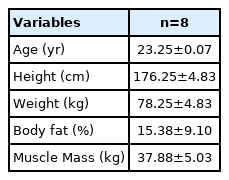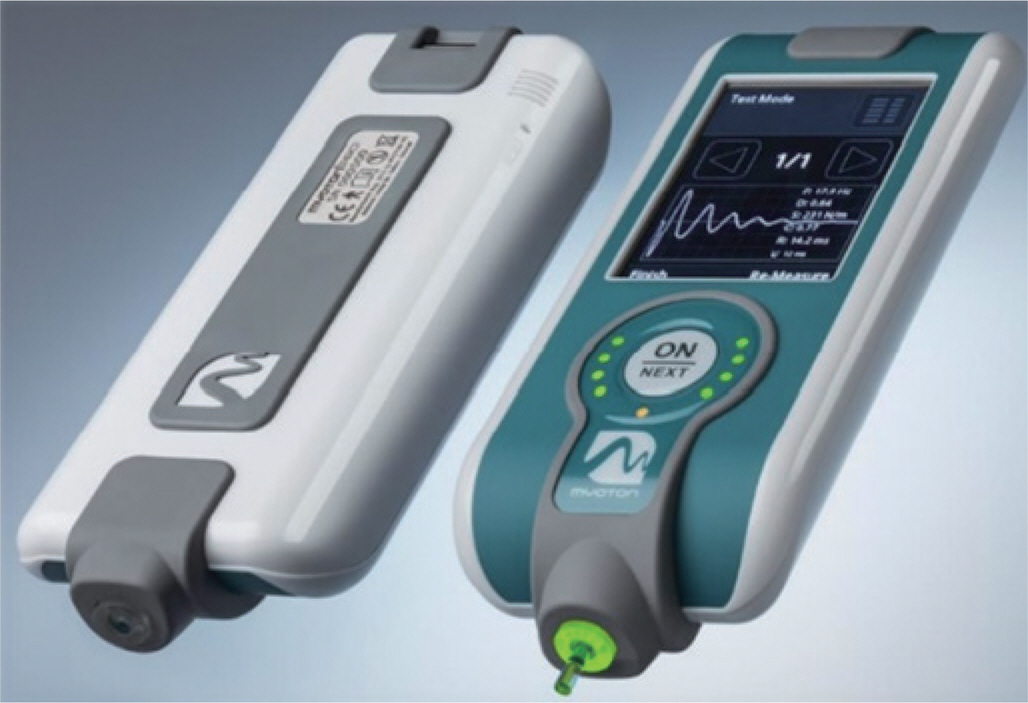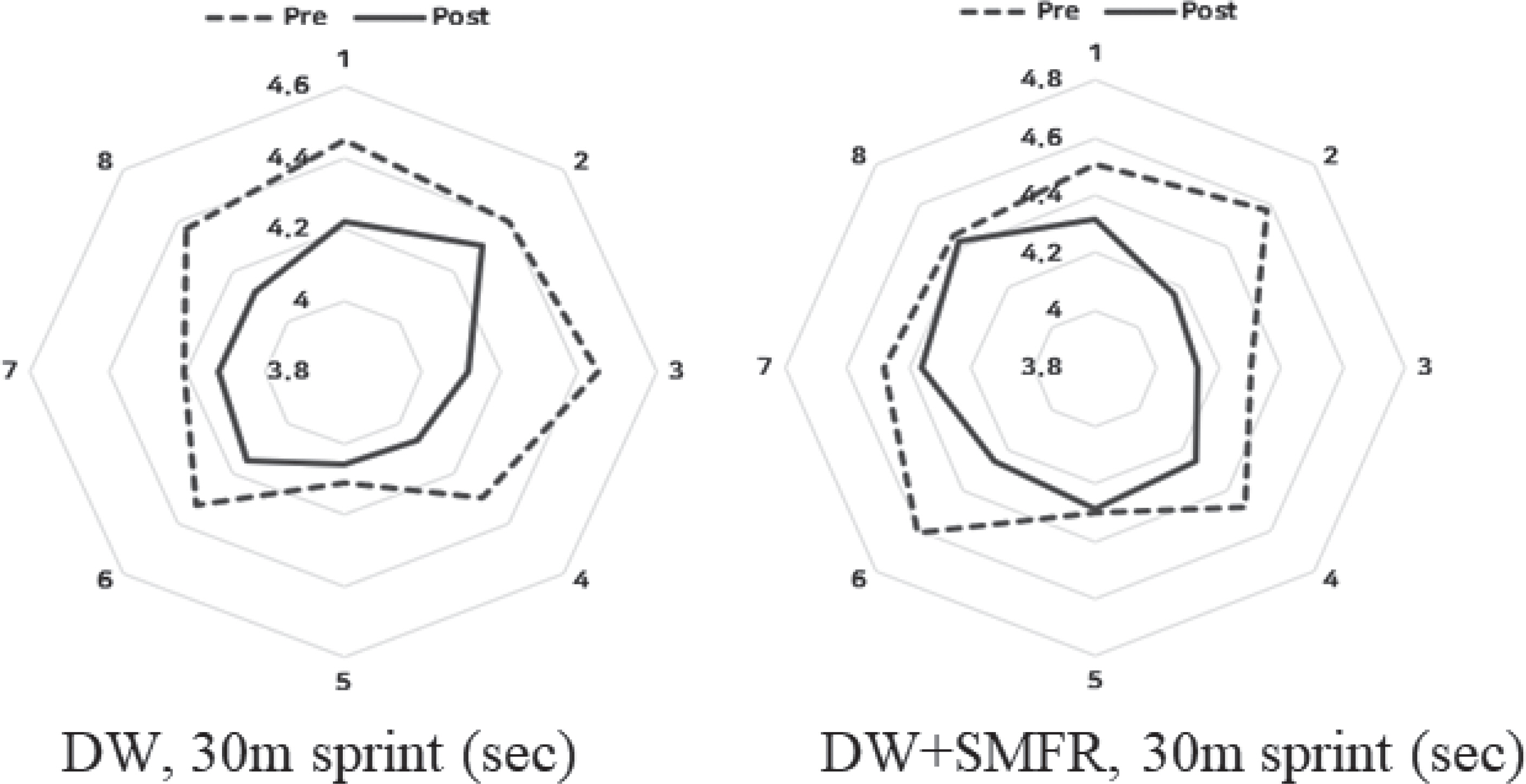자가근막이완을 포함한 동적 준비운동 프로그램이 연부조직의 강직도 및 운동수행능력에 미치는 영향
Effects of Dynamic Warm-up Programs Including Self-Myofascial Relexation on Soft Tissue Stiffness and Exercise Performance
Article information
Trans Abstract
PURPOSE
This study aimed to investigate the effect of dynamic warm-up (DW), including DW and self-myofascial release (SMFR), on soft tissue stiffness and exercise performance.
METHODS
Eight adult men participated in this study. The procedure was conducted twice every 2 weeks. Soft tissue stiffness measurements and exercise performance were performed as a pre-post-test. DW only and DW with SMFR were performed as an exercise intervention for the two groups, respectively.
RESULTS
In the group conducted solely by DW, the stiffness of the gastrocnemius and rectus femoris muscles increased (p<.05), and in the DW group including SMFR, the stiffness of the rectus femoris muscle (p<.01) and biceps femoris muscle increased (p<.05). The Achilles and patellar tendon showed no significant changes in either group. A significant increase was observed in both the DW group and the DW group containing SMFR in the 30 m sprint (p<.01). The vertical jump (VJ) showed no significant change in both groups.
CONCLUSIONS
Therefore, DW, including DW with SMFR, increased muscle stiffness, specifically through a 30-m sprint. In a follow-up study, it is considered necessary to investigate the effect of the VJ through the development of a DW program that changes the stiffness of tendons.
서 론
운동 전 실시되는 준비운동(warm-up)은 부상의 위험을 줄이고 운동수행능력을 향상시키기 위해 실시된다[1–3]. 준비운동을 실시하는 가장 중요한 목적은 신체의 체온 상승이다. 체온의 상승은 근 섬유 내의 온도를 상승시키고 근육의 대사를 효율적으로 변화시킨다고 알려져 있다[4–6]. 준비운동의 효과를 최초로 보고한 Asmussen & Boje [7]는 모든 유기체(organism)의 온도가 일정 수준 상승할수록 효과적인 신체 활동을 할 수 있다고 보고하였다. 근 섬유 내의 온도가 1° 상승할수록 약 2-5%의 운동수행능력을 향상시키며[8], 근 섬유 내의 온도 상승은 힘의 생성과 강한 상관관계가 선행연구에서 입증되고 있으므로 근 섬유 내 온도를 상승시키는 것이 준비운동에서 중요한 핵심 요인이다[9].
지금까지 생활체육 및 피트니스 현장에서 이루어지는 보편적인 준비운동은 기본적인 유산소운동과 더불어 부상의 위험을 감소시키기 위한 정적 스트레칭(static stretching, SS)을 실시하는 것이다. SS는 긴장된 근육의 유연성을 증가시켜 관절운동범위(range of motion, ROM)의 향상을 도모하는 데 효과적이라는 이유와 특정 근육의 과 긴장성(hy-per stiffness)이 본 운동 시 부상 위험을 증가시킬 수 있다는 전통적인 인식에 의해 준비운동에 주로 사용되어 왔다[10,11]. 하지만 본 운동 전 SS가 연부 조직의 부상을 감소시킨다는 객관적인 증거가 없으며[12], 오히려 사전 준비운동에 SS를 포함하면 운동수행능력(예: 점프, 달리기)이 감소되는 연구결과가 지속적으로 보고되고 있다[11,13]. Chaabene et al. [11]는 SS 적용 후 과한 연부 조직의 이완이 근육과 건의 길이-장력 관계(length-tension relationship)에 변화를 일으키고 연부 조직의 강직도(stiffness)에 부정적인 영향을 미치는 것으로 보고하였다. 연부 조직의 변화는 운동수행능력과 관련된 신장-단축 사이클(stretch-shortening cycle, SSC)에도 부정적인 영향을 미치는 것으로 보고되고 있다[14–16].
그러므로 생활체육 및 피트니스 현장에서는 운동수행능력 향상을 위한 준비운동으로써 체온을 효과적으로 상승시키며, 연부 조직의 긍정적인 변화를 유도하는 동적 준비운동(dynamic warm-up, DW)을 권장하는 추세이다[4,5]. DW가 운동수행능력을 향상시키는 기전은 근 섬유 내의 온도를 효과적으로 상승시키며 이로 인해 에너지 대사의 효율성 증가 및 근 섬유의 신경전도속도(muscle fiber conduction velocity, MFCV)를 빠르게 증가시키는 것이다[17–19]. 또한 DW가 일시적으로 연부 조직의 강직도를 높여 이로 인해 운동수행능력을 증가시킨다는 생리학적 기전이 보고되고 있다[20].
한편, 자가근막이완(self-myofascial release, SMFR)은 근막 섬유의 유착을 해결하며, 근막의 기능 회복을 유도하고 근육 및 건 등 연부 조직의 신장성을 회복하는 데 사용된다고 알려져 있다[21]. SMFR은 특정 도구(예: form roller) 위에 자신의 체중을 이용하여 해당 부위에 압박을 가하는 형태로 실시되며, 이때 발생된 마찰력이 근막의 온도를 상승시키기 때문에 근막이 유체와 같은 형태를 취하도록 촉진한다[22]. SMFR의 적용을 통해 이완된 근막은 ROM을 증가시키고 운동수행력 향상에 영향을 미치는 것으로 나타났다[22–25]. 구체적으로 MacDonald et al. [22]이 보고한 연구에 따르면 SMFR 후 무릎관절의 ROM이 10.3% 증가하였으며, Behara & Jacobson [23]은 SMFR을 적용하고 1분 뒤 엉덩관절의 굴곡 ROM이 15.6% 증가되었다고 보고하였다. 또한, Peacook et al. [26]의 연구에서는 SMFR을 적용시킨 그룹이 DW를 적용한 그룹보다 수직점프(vertical jump, VJ) 및 민첩성, 최대근력과 같은 운동수행능력이 모두 높은 수준으로 향상되었으며, Mikesky et al. [27]와 Healey et al. [28]이 보고한 연구에서도 SMFR 적용 후 VJ가 향상되었다고 보고하였다.
앞서 언급한 바와 같이 SMFR과 DW는 운동수행능력의 향상과 더불어 ROM을 증가시켜 부상 위험까지 감소시킨다. 특히, DW와 SMFR 은 생활체육 및 피트니스 현장에서 매우 간편하게 사용할 수 있으며, 비용이 들지 않아 현장 적용성 차원에서 생활체육인들에게 권장될 필요가 있다. 하지만 DW 및 DW+SMFR을 결합하여 실시한 후 운동수행능력의 변화 및 연부조직의 강직도에 미치는 영향을 분석한 연구는 전무한 실정이다. 따라서 본 연구는 DW 및 DW와 SMFR을 결합하여 적용하였을 때, 연부 조직의 강직도와 운동수행능력에 미치는 영향을 검증하여 생활체육인들에게 효율적인 준비운동 방법을 구체적으로 제시하는데 목적이 있다.
연구 방법
1. 연구 대상
이 연구는 최근 6개월간 수술 및 골절, 부상 경험이 없는 C 지역 소재의 대학생 남자 8명을 대상자로 선정하였다. 실험 전 모든 대상자에게 연구의 과정과 목적, 연구 참여로 인해 발생되는 이익과 위험에 대해 충분한 설명을 한 후 연구 참여 동의서에 서명을 받아 자발적으로 연구에 참여하였다. 연구 대상자의 신체적 특징은 Table 1과 같다.
2. 연구 절차
이 연구는 8명의 대상자에게 운동 중재(exercise intervention)는 1차시기(1st period) DW 방법을 실시하고, 2주 후(washout period) 동일한 대상자에게 2차시기(2nd period) DW+SMFR을 실시하였다. 1차시기와 2차시기의 운동 중재를 제외한 나머지 전반적인 연구 절차는 동일하게 적용하였다. 세부적인 실험 순서는 연부 조직 강직도 검사(myoton)를 pre test 1로 측정하였으며, 운동손상예방을 위한 10분간 달리기(running)를 실시하였다. 그 후 운동수행능력 검사(30 m sprint, vertical jump)를 pre test 2로 실시하였다. 마지막으로 연부 조직 강직도 검사(myoton) 및 운동수행능력 검사(30 m sprint, vertical jump)를 post test 로 실시하였다. 이 연구 절차는 Fig. 1과 같다.
3. 측정 항목
1) 연부조직 강직도
연부 조직의 강직도 측정은 근 긴장도 측정기(Myotonpro, Myoton AS, Estonia)를 이용하여 건과 근육의 강직도를 측정하였다(Fig. 2). Myotonpro는 연부 조직의 정량적 강직도를 측정하는 데 적합한 장비로 보고되고 있다[29,30]. 대상자의 발뒤꿈치힘줄과 장딴지근, 넙다리두갈래근은 엎드린 자세에서 측정하였으며, 무릎힘줄과 넙다리곧은근은 누운 자세에서 측정하였다. 근 긴장도 측정기의 probe를 사전 표시된 측정지점 피부 표면 위에 수직으로 놓은 후, 피부를 압박하여 측정 위치에 도달시켜 녹색불이 켜진 상태에서 측정하였다. 측정된 결과의 변인 중 3% 이상의 오차 범위가 나타날 경우 자료를 삭제하고 다시 측정하였다. Myotonpro의 5가지 측정 변인(frequency, stiffness, decre-ment, relaxation, creep) 중 생체역학적 특성을 나타내는 Stiffness를 자료에 활용하였다.
2) 운동수행능력 검사
(1) 30 m 전속력 달리기
30 m 전속력 달리기(30 m sprint)는 측정자의 신호에 출발하여 30 m 를 전력질주한 기록을 측정하였으며, 측정 전 부상 위험을 방지하기 위하여 70-80%의 속도로 1회 예행연습을 하였다. 총 2회를 실시하여 빠른 기록을 자료로 활용하였다.
(2) 수직 점프
VJ는 양팔의 움직임을 최대한 활용하는 점프(counter movement jump, CMJ)를 실시하였다(TKK-5406, TAKAI, Japan). 양발을 어깨너비로 벌린 후 최대 높이로 점프하도록 유도하였으며, 총 2회의 기록 중 가장 높은 기록을 자료로 활용하였다.
3) 동적 준비운동(dynamic warm-up, DW)
DW 프로그램은 Aguilar et al. [1]이 제안한 동적 준비운동 프로그램을 연구 목적에 맞게 수정 보완하여 실시하였다. DW는 1단계 동적 운동(동적 스트레칭, 민첩성, 평형성)과 2단계 신경 활성화(neural activation)를 위한 가속달리기로 구분되어 실시하였다. 10 m 간격으로 총 20 m의 표시 마커를 세워 놓은 후, 처음 10 m까지 1단계 동적 운동을 실시하였으며 10 m가 지난 후 20 m까지는 2단계 가속달리기를 수행하였다. 20 m까지 1단계 동적 운동과 2단계 가속달리기가 끝난 후 처음 위치로 회복하여 돌아오도록 하였다. 이 과정은 DW의 프로그램이 완료될 시까지 반복되었으며, 1단계 동적 운동과 2단계 가속달리기의 강도와 난이도는 프로그램이 진행됨에 따라 증가하였다. DW의 프로그램은 대상자들이 충분히 숙지할 수 있도록 측정자가 시범을 보인 후 반복 숙지하였다. DW의 세부사항(운동종류, 방법, 반복 횟수 및 강도)은 Table 2와 같다.
4. 자료 처리
이 연구에서 측정된 모든 자료는 SPSS 22.0 Window version을 이용하였으며, 기술 통계를 활용하여 평균과 표준편차(M±SD)를 산출하였다. 8명의 동일한 대상자에게 DW 운동 중재 방법(1차시기)과 DW+SMFR 운동 중재 방법(2차시기)을 각각 적용한 후에 연부조직 강직도 및 운동수행능력에 나타나는 시기 간의 효과를 비교 분석하기 위하여 대응 표본 t-검정(paired t-test)를 실시하였다. 이 연구의 모든 통계적 유의 수준은 α=.05로 설정하였다.
연구 결과
1. 연부조직 강직도
DW 운동 중재 방법(1차시기)과 DW+SMFR 운동 중재 방법(2차시기)이 연부조직에 미치는 영향을 평가하기 위해 근 긴장도 측정기(myoton)를 사용하여 시기에 따른 차이를 분석하였다. 그 결과 장딴지근은 DW 운동 중재 방법에서 강직도가 유의하게 증가하였다. 또한, 넙다리곧은근의 경우 DW 운동 중재 방법과 DW+SMFR 운동 중재 방법에서 모두 유의하게 강직도가 증가하였다. 넙다리두갈래근은 DW+ SMFR 운동 중재 방법에서만 유의하게 강직도가 증가하였다. 그 외 다른 근육 및 건에서는 유의한 수준의 결과가 관찰되지 못하였다(Table 3).
2. 운동수행능력
DW 운동 중재 방법(1차시기)과 DW+SMFR 운동 중재 방법(2차시기)이 운동수행능력에 미치는 영향을 평가하기 위해 30 m sprint 및 VJ 평가 방법을 사용하여 시기에 따른 차이를 분석하였다. 그 결과 Fig. 3에서 보여지듯 30 m sprint는 DW 운동 중재 방법과 DW+SMFR 운동 중재 방법에서 모두 유의한 수준으로 기록이 향상되었다. 하지만 VJ는 DW 운동 중재 방법과 DW+SMFR 운동 중재 방법 모두 통계적으로 유의한 수준의 기록이 관찰되지 못했다(Table 4).
논 의
중강도 이상의 DW는 근육 및 건과 같은 연부 조직의 강직도를 상승시킨다고 알려져 왔다[20]. 연부 조직의 강직도 상승은 고강도 준비운동 프로그램이 일시적으로 운동수행능력을 향상시키는 기전인 근 활성화 후 상승효과(post activation performance enhancement, PAPE)를 위한 생리학적 기전 중 하나이다[20,33]. 근 수축 직후 발생하는 연부 조직의 강직도 변화는 척수(spinal cord) 수준의 흥분성 즉, 운동뉴런(motoneuron)의 생산량(output) 증가에 의해 발생하며 연부 조직 내 혈류 및 수분량의 상승이 강직도를 증가시키는 주된 원인으로 보고되고 있다[20,34].
특히, Lin et al. [35]은 dynamic stretching (DS)과 DS+VFR (vibration foam rolling)의 효과를 비교한 결과, DS는 넙다리네갈래근과 장딴지근의 강직도를 증가시켰으며, DS+VFR은 넙다리네갈래근의 강직도를 감소시킨 것으로 보고하였다. 반면 Meerits et al. [36]은 동적 스트레칭이 넙다리두갈래근과 반힘줄모양근의 강직도 변화에 영향을 미치지 못했다고 보고하였다. 이 연구에서 DW 운동 중재 방법은 장딴지근과 넙다리곧은근, DW+SMFR 운동 중재 방법은 넙다리곧은근과 넙다리두갈래근의 강직도에서 유의하게 증가하였다. 따라서 선행연구를 포함한 모든 연구에서 근육의 강직도의 변화가 다르게 나타났으며, 준비운동의 강도, 방법 및 시간 등이 근육의 강직도 변화에 다르게 영향을 미쳤을 가능성이 있다.
한편, 일반적으로 플라이오메트릭 동작 후의 런닝은 힘줄의 강직도를 증가시키며, 탄성 에너지의 저장 및 방출량을 높여 점프와 같은 폭발적인 움직임을 강화시킨다[37]. 특히 Bohm et al. [38]은 높은 강도의 훈련은 낮은 강도의 훈련보다 강하고 빠른 힘줄의 적응을 발생시킨다고 보고하였다. 또한 준비운동 프로그램의 유형에 따른 힘줄의 강직도를 측정한 Pieters et al. [39]은 플라이오메트릭 형태의 준비운동이 발뒤꿈치힘줄의 혈류량 및 강직도를 증가시킨다고 보고하였다. 이 연구에서 DW와 DW+SMFR 운동 중재 방법은 발뒤꿈치힘줄과 무릎힘줄의 강직도 변화에 긍정적인 영향을 주지 못하였다. Park et al. [37]은 정적 및 동적 준비운동이 힘줄의 강직도에 긍정적인 효과가 나타나지 않았다고 보고하면서 힘줄의 강직도 변화에 필요한 강도 높은 준비운동 프로그램을 적용할 것을 제안하였다. 즉, 점프가 포함된 준비운동을 실시한 선행연구에서는 힘줄의 강직도 상승이 관찰된 반면[40], 이 연구에서는 점프와 같은 동작이 포함되지 않은 DW 및 DW+SMFR을 실시하였기에 강직도 상승이 관찰되지 않았다고 판단된다.
한편, McMillian et al. [14] 등은 세 가지의 준비운동이 운동수행능력에 미치는 영향을 관찰한 결과 DW 그룹이 NW (no warm-up) 및 SW (static warm-up) 그룹보다 t-test 및 5-step jump, 메디신볼 던지기 검사에서 유의하게 향상되었다고 보고하였으며, DW 그룹이 NW와 SW 그룹보다 높은 수준의 평균 파워(average power)를 기록하였다[41]. 또한 Bojsen et al. [42]와 Kubo et al. [43]이 보고한 연구에서 발뒤꿈치힘줄과 무릎힘줄의 강직도는 점프력과 유의한 수준의 상관관계가 관찰되었으며, Chelly & Denis [44]가 보고한 연구에서는 하지 연부 조직의 강직도가 높을수록 sprint 능력에 긍정적인 효과를 미친다고 주장하였다. 이 연구에서 측정된 운동수행능력은 DW와 DW+SMFR 운동 중재 방법을 적용한 그룹 모두에서 30 m sprint 기록이 유의한 수준으로 기록이 향상되었다. 하지만 VJ에서는 두 그룹 모두 유의한 수준의 기록 향상이 나타나지 않았다. 연부 조직의 강직도 증가로 운동수행능력이 향상된다는 직접적인 관계를 파악하기에 이 연구의 방법으로는 어려움이 있지만 높은 강도로 실시된 DW가 근육 강직도 상승에 영향을 미쳤을 가능성이 있으며, 이로 인해 30 m sprint 기록을 향상시킨 것으로 유추할 수 있다. 또한, 앞서 언급한 Pieters et al. [39]의 선행연구의 준비운동 방법인 플라이오메트릭성 점프 훈련이 포함된 준비운동 방법으로 힘줄의 강직도를 증가시켰지만, 이 연구의 준비운동 방법에는 플라이오메트릭성 동작이 포함되지 않았기 때문에 힘줄의 강직도 상승이 나타나지 않았으며, 이로 인해 VJ에 아무런 영향을 주지 못했다고 판단된다.
결 론
이 연구에서 DW 운동 중재 방법은 장딴지근과 넙다리곧은근의 연부조직 강직도의 증가 및 30 m sprint 기록 향상에 효과가 있었다. 또한, DW+SMFR 운동 중재 방법은 넙다리곧은근 및 넙다리두갈래근의 연부조직 강직도의 증가 및 30 m sprint 기록 향상에 효과가 있었다. 따라서 30 m sprint가 반복적으로 수행되는 필드 종목의 경기력 향상을 위한 준비운동 프로그램으로 이 연구에서 제시된 DW 또는 DW+SMFR 의 현장 적용이 가능하다. 추후 연구에서는 다양한 대상자, 더 많은 연구 표본 수, DW 및 DW+SMFR의 장기간 적용과 함께 힘줄의 강직도 변화를 주는 DW 프로그램의 개발을 통해 VJ에 미치는 효과에 대해 규명할 것을 제안한다.
Notes
이 논문 작성에 있어서 어떠한 조직으로부터 재정을 포함한 일체의 지원을 받지 않았으며, 논문에 영향을 미칠 수 있는 어떠한 관계도 없음을 밝힌다.
AUTHOR CONTRIBUTION
Conceptualization: SY Seon, KJ Lee; Data curation: SY Seon, KJ Lee; Formal analysis: KO An, KJ Lee; Methodology: SY Seon, KO An; Project administration: SY Seon, KJ Lee; Visualization: SY Seon, KO An, KJ Lee; Writing-original draft: SY Seon, KO An, KJ Lee.







